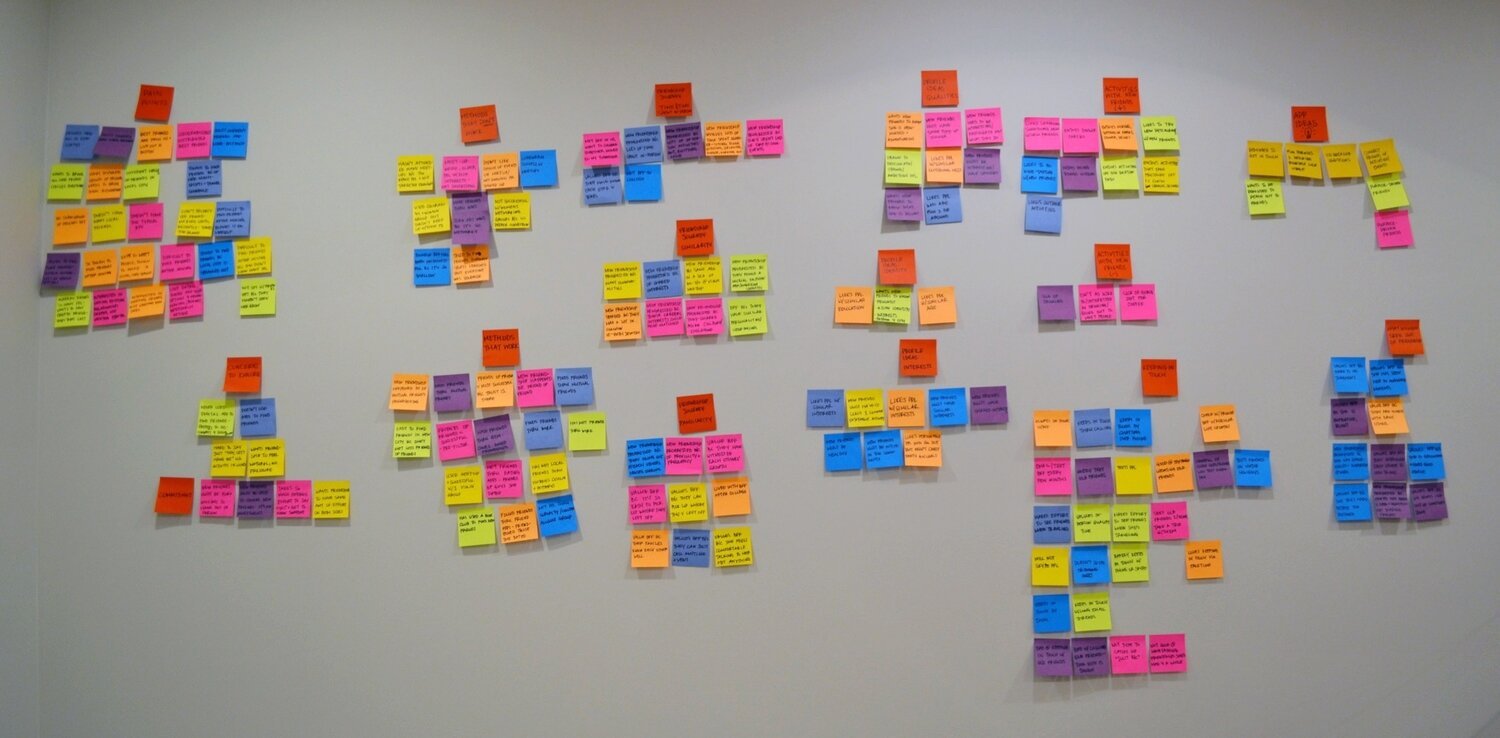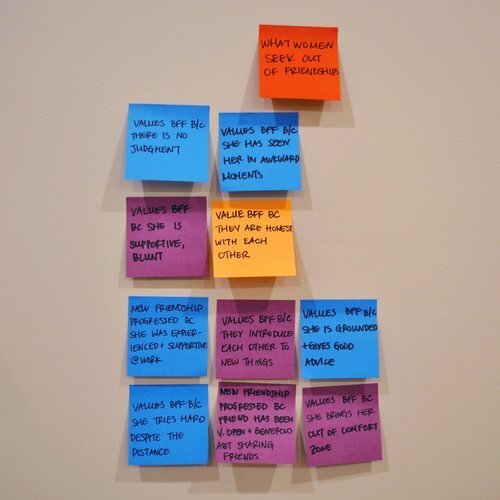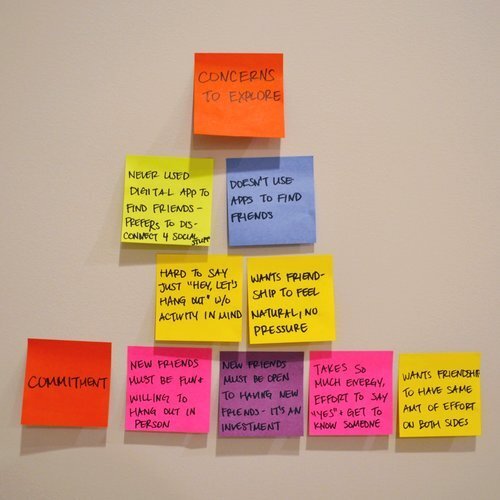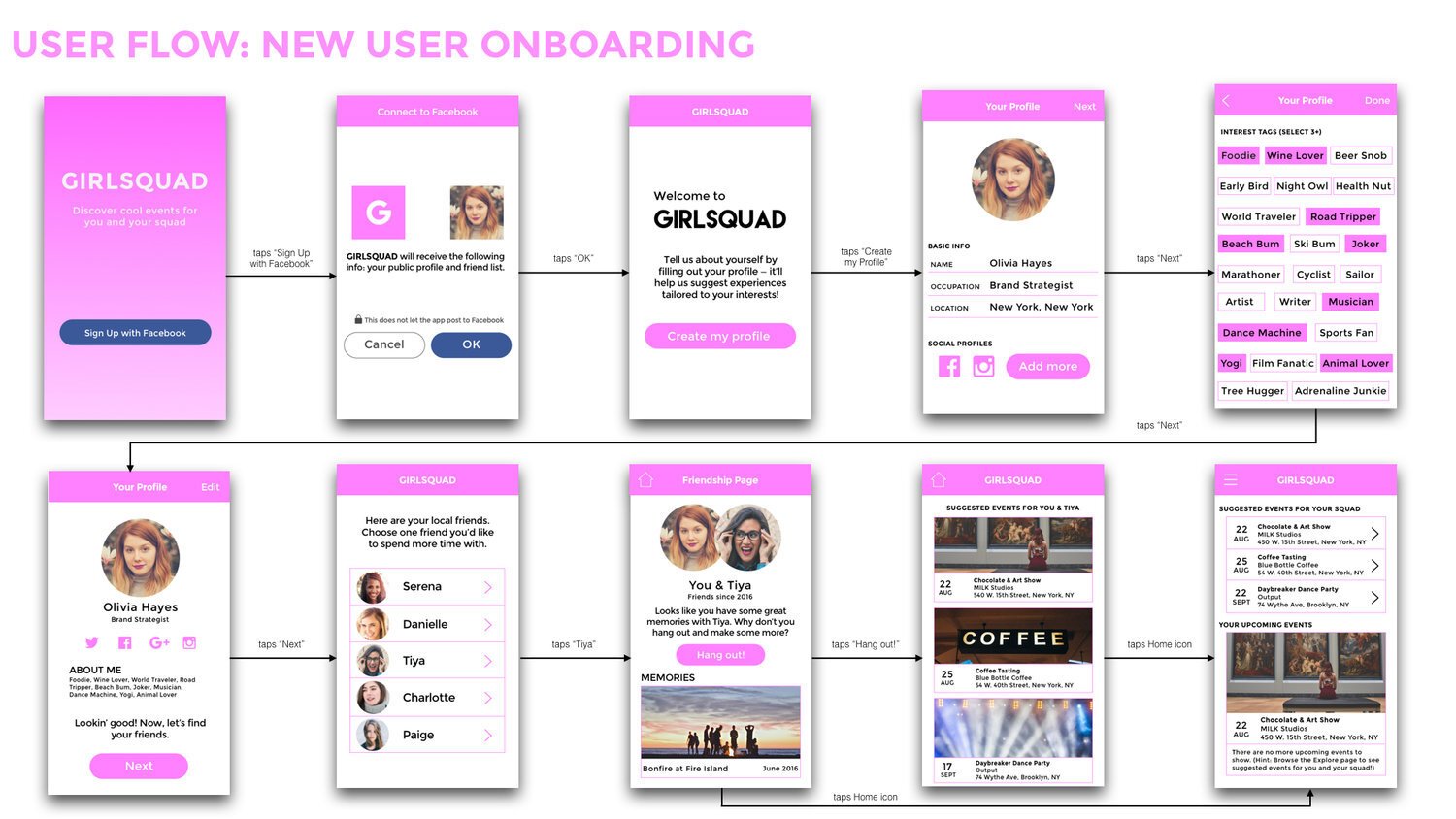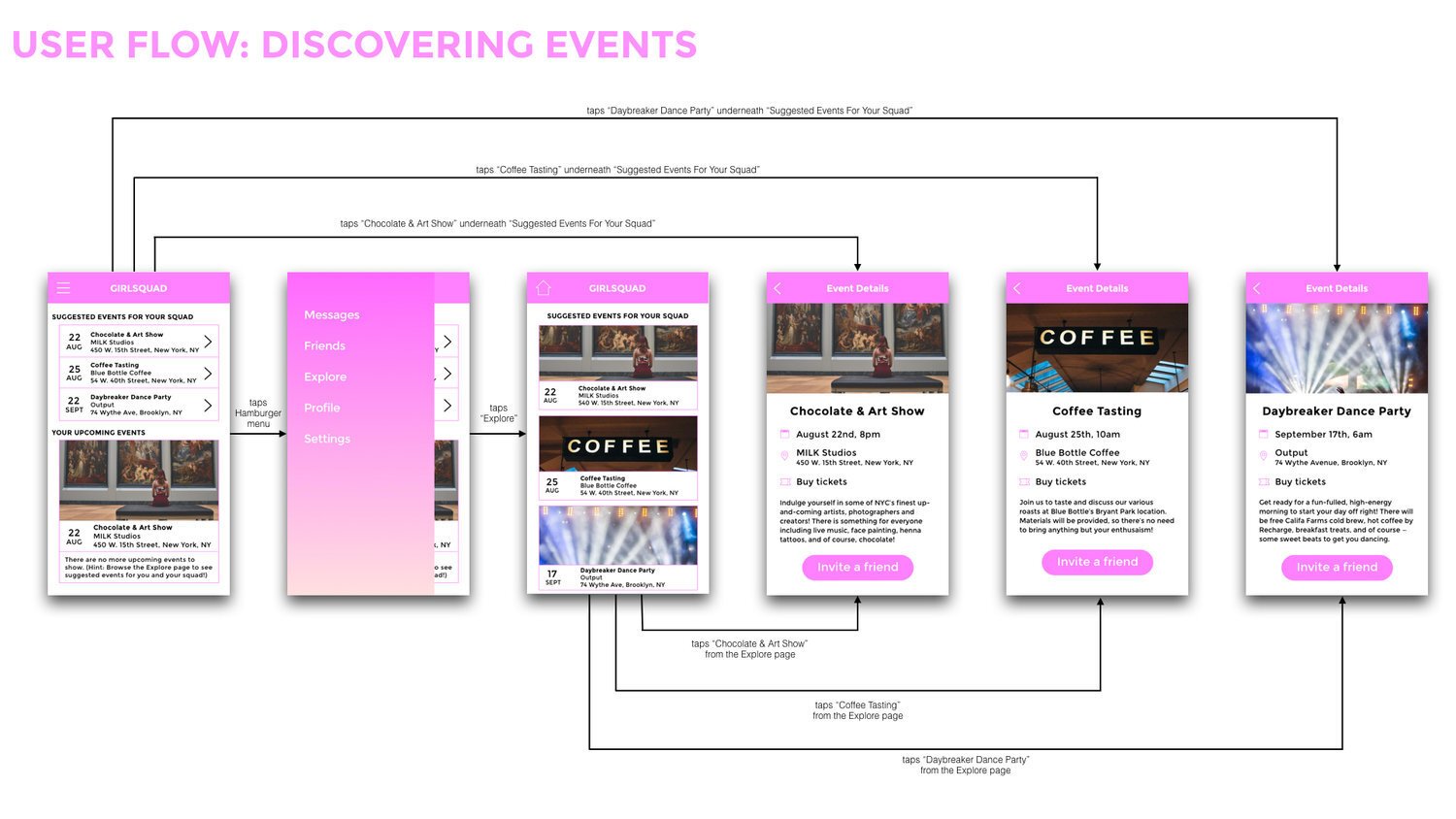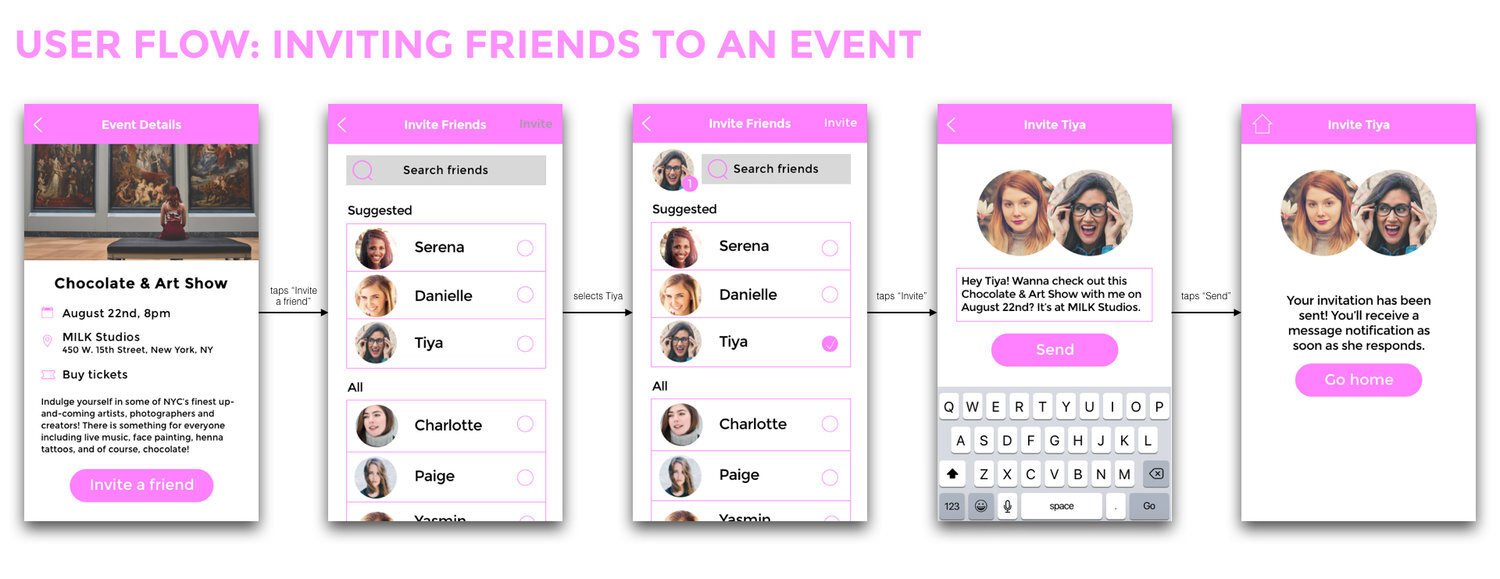Girlsquad
Empowering Female Friendships
As a project I really wanted to chose a topic that was both a proven need in the marketplace and of deep personal interest: friendship-building amongst recently relocated millennial women.
I was responsible for synthesizing user research and customer feedback to design and iterate on a solution, and for producing a full suite of UX documentation.
About
The Challenge
MILLENNIAL WOMEN WHO HAVE RECENTLY RELOCATED NEED A WAY TO NURTURE GENUINE FRIENDSHIPS IN ORDER TO BE HAPPY IN A NEW CITY.
Background
Consider this: Millennials are relocating at significantly higher rates than in the past.
59% of millennials (18-35 year olds) currently live in a locale other than their hometown.
80% of millennials have moved at some point in their lives, not including moves made to attend college.
Source: Mayflower Mover Insights Study
Along with relocating comes a big social challenge: Millennial women find it difficult to make friends after moving.
85% of users interviewed agreed that it’s difficult to find friends after moving.
100% of users interviewed agreed that it’s easy to meet people, but difficult to turn those acquaintances into deeper friendships.
43% of users interviewed want to bring disparate pockets of friends together to form a core group.
User Research
HERE'S A CLOSER LOOK AT THE INSIGHTS FROM INTERVIEWS WITH 7 MILLENNIAL WOMEN.
Key Insights
Time spent together is crucial - best friends have known each other for years, and new friendships progressed quickly when a lot of quality time was spent together in person.
“I value my best friend because she’s seen me grow throughout the years.”
Similarity in identity, personality, and interests is important for building friendships.
Familiarity & knowing each other well is a key indicator of a deep friendship.
“I value my best friend because we can instantly pick up right where we left off — even if its been a while.”
INSIGHTS THAT INFLUENCED THE PRODUCT
“I’m more interested in making existing relationships deeper, rather than making new friendships altogether.”
“Friend-making is hard.”
“You can meet a friend anywhere, anytime — but how do you keep those friends?”
Millennial women need a way to cultivate current acquaintances into friendships, not meet new people altogether. This denoted a major pivot in my vision for the product — I nixed the idea of creating yet another "Tinder for Friendships," and instead decided to concentrate on enriching existing relationships.
There is no shortcut for spending quality, in-person time with a friend. This insight persuaded me to focus my product on facilitating interesting, shared experiences between friends.
Current methods don’t work when they are superficial (ie. networking groups or Tinder-like apps), or bring extremely different people together (ie. Meetup). This is why the GIRLSQUAD MVP will start with curating local, "off-the-beaten path" events that will inspire conversation and genuine bonding, rather than prompting people to grab coffee or drinks.
The GIRLSQUAD MVP Proposal
THE PROBLEM
Millennial women need a way to strengthen superficial acquaintances into deeper friendships, as 85% of users interviewed agreed that it’s difficult to cultivate genuine friendships after moving to a new city.
THE OBJECTIVE
Facilitate genuine friendships between millennial women by curating interesting shared experiences for friends to attend together, ultimately helping them create a stronger, closer bond.
TARGET AUDIENCE
Millennial women (ages 18-34) who have recently relocated to a new city
COMPETITIVE DIFFERENTIATORS
GIRLSQUAD focuses on strengthening existing friendships, instead of meeting new people altogether. This means facilitating in-person quality time, rather than matching the user with other random users.
There is no romantic stigma attached to GIRLSQUAD. If the user wants to see more details about a friend, clicking on that friend’s “Profile” will take her to a "Friendship Page," where she can see memories they’ve shared together.
GIRLSQUAD has a big emphasis on personalization, and will curate a handful of quality events specifically for pairs or small groups of friends.
User Persona
Site Map
After conducting a few rounds of card sorting, I produced two iterations of the site map. The first version represents the ideal v2 of the product, including features in the future roadmap like "Past Events" and "Event Feedback". Some ideas I incorporated into the site map from card sorting include:
Focusing on the "Friendship Page", rather than individual profiles in “Your Friends” — This speaks directly to GIRLSQUAD’s emphasis on relationships.
Making the CTA to “Hang out!” top priority in the information hierarchy — Making the CTA easy to find will help encourage action from the user.
Organizing “Events” in a more logical way — I originally had a separate flow for "Event Feedback” under the Friendship Page, but it makes more sense to have all event-related pages together. It’s also important to clearly differentiate “Upcoming Events” and “Explore Events,” because the user will interact uniquely with the information on those pages.
User Flow
To help guide my design process, I created a "happy path" user flow early on during the project. This represents the ideal path that the primary user takes — from how she decides to use the app, to setting up her profile, to inviting a friend to an event. I've also broken down this initial user flow into three separate task flows, where you can see the actual screens for: new user onboarding, discovering events, and inviting friends to an event.
Key Screens
From ideation, to sketching, to high-fidelity wireframes, here is the evolution of GIRLSQUAD's key screens.
You'll see the progression of my understanding of iOS design patterns: bigger buttons, proper use of the "back" icon, and standard navigation. You'll also see the grouping of relevant information into cards, enabling users to quickly understand the content of each screen.
Lastly, you'll see that a few elements have been taken out — like the icons on the home screen, and "Friends who'd enjoy this event" on the event details screen.
These changes were made after several rounds of user testing in order to eliminate confusion, and simplify the user's decision-making process.
Reflections and Future Considerations.
As with any project, there is always room for improvement. I've learned that user testing delivers incredibly valuable information, and would have liked to interact with more users had I had more time in the class.



